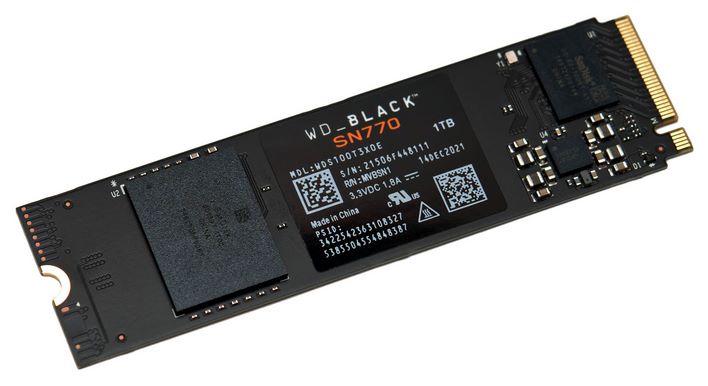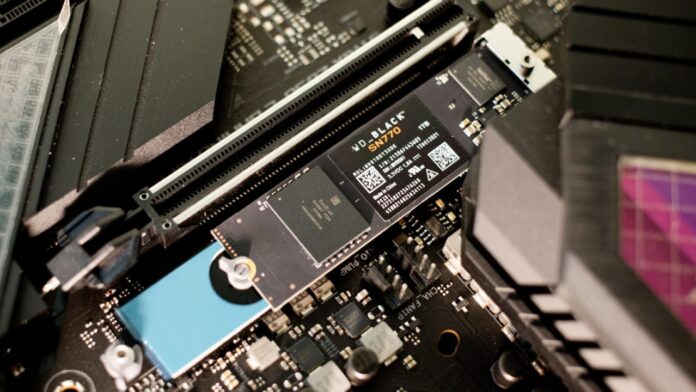The WD Black SN770 offers a logical upgrade from Gen 3 NVMe without the hefty expense connected with top-end Gen 4 SSDs, unless you buy a PS5. The SN770 is a great option for those constructing a low-cost gaming setup.
The majority of desktop PCs and laptops now use PCIe NVMe technology, however some still use SATA SSDs and some even traditional hard drives.
The price premium isn’t as large as it formerly was, and it delivers the smallest form factor, fastest speeds, and best power efficiency. SSD manufacturers have adopted the new Gen 4 standard for these devices in an effort to differentiate their goods, adding to the price stratification.
At the top of this spectrum, we have items like the Samsung 980 Pro, WD Black SN850, and Seagate FireCuda 530, all of which have read speeds on PCIe 4.0 M.2 slots that exceed 7,000MB/s.
For those looking to get the best performance out of an AMD Threadripper or Intel 12th-gen processor, that is near to the theoretical maximum for this interface.
However, not everyone is willing to pay for these top-of-the-line products, therefore some manufacturers are providing workable options that more people can afford.
One of these choices is the new WD Black SN770, which guarantees read speeds of 5,000MB/s for less money per GB than the more expensive end of the market. Is this something to think about, or should you save your money for a larger Gen 3 drive or a more compact high-performance item?
Design & Build

The shape of the SN770 is as generic as they come for 2280 NVMe drives. The NAND package is on the top side’s left, the controller is on the right, and there are a few discrete components all around it.
There are no components on the underside that can be seen, there is no heatsink integrated in this design, and WD does not offer any alternatives.
The SN770 is built utilising 112-layer TLC NAND flash and a custom SanDisk controller that communicates with the host PC using NVMe 1.4 over a PCIe 4.0 bus.
The current NVMe trend is to employ either SLC caching or, in the case of the SN770, RAM in the host PC as a buffer rather than DRAM to smooth transfers.
The lack of a DRAM cache saves money but affects performance; the degree of this speed reduction depends on the amount of disc space still available for dynamic SLC caching and the strength of the host system’s memory subsystem.
The Western Digital SN770 is not the first NVMe SSD I’ve seen with this setup. It previously employed this strategy on many designs, including the SN570.
The Sony PS5 does not support the host memory buffer (HMB) method, which is a drawback. That would be more of an issue if Western Digital sold the SN770 specifically for this use, but it is also slower than the PS5’s low watermark of 5,500MB/s for third-party modules.
Western Digital clearly advised me not to test the review sample on a PS5, and while this might work in some way, I wouldn’t advise you to do it.
I would recommend a third-party heat spreader for all PC deployments. Although I didn’t see thermal throttling during my experiments, preventing any excessive heat buildup is likely to increase the life of the drive and allow it to function at its highest rates.
Verdict

The SN770 replaces the venerable SN750, a Gen 3 drive that reached its highest reading and writing speeds of 3,400MB/s and 3,100MB/s, respectively.
Even for those who are still using Gen 3 slots, the SN770 offers a significantly better value than the SN750. It benefits laptop users because it has significantly higher power efficiency.
The SN770 line lacks a 4TB model, which is the sole letdown given that the SN750 featured one. According to the official data, WD added a dubious 250GB option to the models in order to pad them out.
Although the 500GB model is less constrained, the 1- and 2TB models shine in terms of performance and value, so I’d suggest those.
For individuals who are performing mission-critical exercises where performance is crucial, this motivation appears less alluring. It can’t maintain its writing speeds over an extended period of time and isn’t the fastest Gen 4 drive.
However, it’s OK for brief sprints, such as when games are launched. The sole error committed by Western Digital was allowing the performance to go below what was required for PS5 approval, which disqualified a large portion of potential customers.
The WD Black SN770 is an excellent option for PC gamers on a tight budget. It has a speed that is fast enough to start games swiftly, yet it is around 40% less expensive than flagship branded models. Even taking into account the cost of an additional heat spreader, it still provides an excellent value.
At this price, you won’t be able to obtain the fastest drive imaginable, but if all you need is a reliable workhorse gaming SSD, the SN770 is a good option.
Specs
WD Black SN770: Specs
- Capacities: 250GB, 500GB, 1TB and 2TB
- Colour: Black
- Controller: WD in house by SanDisk
- Flash Memory: 112-layer TLC NAND
- Dimensions: (L x W x H): 80 x 22 x 2.38mm
- Weight: 5.5g
- Interface: M.2 NVMe PCI slot (PCIe Gen4, downgradable to Gen3, Gen2 and Gen1)
- Quoted Sequential Read (500GB, 1TB, 2TB,4TB): 4,000MB/s, 5,000MB/s, 5,150MB/s and 5,150MB/s MB/s
- Quoted Sequential Write (500GB, 1TB, 2TB,4TB): 2,000MB/s, 4,000MB/s, 4,900MB/s and 4,850MB/s MB/s
- Quoted Random Read/Write IOPS (500GB, 1TB, 2TB,4TB): 240K/480K, 460K/800K, 740K/800K and 650K/800K
- Total Bytes Written (500GB, 1TB, 2TB, 4TB): 200TB, 300TB, 600TB and 1,200TB. Warranty: 5 years


